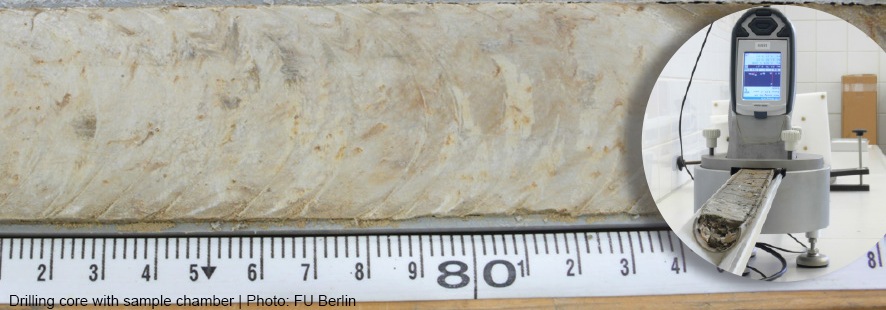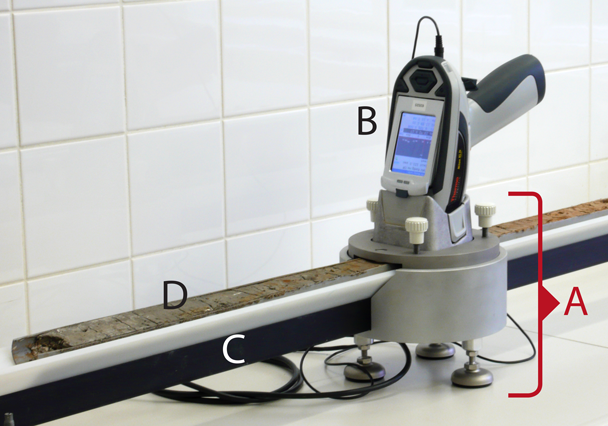Innovations from the geo laboratory

For many years, the working area of the Laboratory for Physical Geography has been highly successfully employing a portable energy-dispersive X-ray fluorescence spectrum analyzer (p-ED-XRF) funded by Topoi for measuring specific elements in solids (e.g. sediment and/or soil samples, ceramics, etc.). An innovative sample chamber has been developed for this analyzer, and is already in use as an auxiliary component of the spectrometer. The auxiliary module allows, for instance, quasi-continuous analysis of sediment drill cores, and thus closes the gap between the individual measurements that can be taken by p-ED-XRF analysis and stationary, highly spatially resolved XRF core scans, which come at an extreme acquisition cost in excess of 300,000 euros.
In 2014 the innovative sample chamber received an utility model protection from the German Patent and Trade Mark Office. The Development of the sample chamber by the FU employees, formulation of the utility model protection by a Berlin patent attorney firm, and the fees for the application to the German Patent and Trade Mark Office were financed by Topoi in the scope of the Forum Spatial Data Analysis and by the Patent and Licensing Service (PULS) of FU Berlin.

The newly developed sampling chamber (A) for coupling the Niton XL3t 900 portable energy-dispersive X-ray fluorescence spectrum analyzer (p-ED-XRF) (B) with the Bartington® core conveying track (C) for analyzing sediment drill cores (D).
In the scope of Topoi, the sample chamber is currently being used to study sediment cores from the geo-archaeological project (A-1-7) Reconstruction of the Local and Environmental Conditions of the Settlement Ayamonte by fellow Torsten Klein. The cores need only be halved for the retrieved sediments to be analyzed. Physical taking of samples – and with it partial destruction of the drill cores – is no longer necessary using this analytical technique. Given the centimeter precision of the p-ED-XRF results (e.g. of the calcium-to-iron ratio), a distinction can be made between terrestrial and marine facial zones and interpreted with regard to the landscape reconstruction. After completion of the process, the drill cores remain intact for further studies and analyses.
Now that the utility model protection is “official” (20 2014 106 048.0 ´Sampling chamber, in particular sampling chamber for analyzing sediment or drill core samples´), the laboratory team is working on the scientific publication of this new sampling chamber technique in order to inspire further collaborations with other scientists.
Author: Philipp Hoelzmann
RELATED LINKS
Topoi research group (A-1-7) Reconstruction of the Local and Environmental Conditions of the Settlement Ayamonte
Laboratory for Physical Geography of the Institute for Geographical Sciences at the FU Berlin
Read more articles in TOPOI FEATURE
